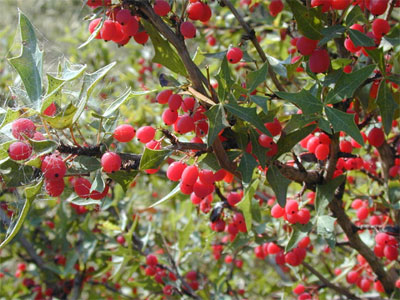Wild About Texas – November, 2007

Agarita berries are delectable to birds in winter.
During the bleak dormancy of the waning months of the year and into the wee months of the next, we all crave life in the garden. Attracting a frisky gaggle of birds can offer just the therapy we seek.
Seeds from plants in the Sunflower or Composite (Asteraceae) family — such as Maximilian and annual sunflowers (Helianthus maximiliani and H. annuus), Engelmann daisy (Engelmannia peristenia), zexmenia (Wedelia texana), and thistles (Circium spp.) — will lure cardinals, juncos, pine siskins, house finches, American (in winter) and lesser goldfinches, painted buntings (in summer), and various sparrows such as savanna, vesper, rufous-crowned, and chipping sparrows, who favor the seed of smaller composites. Native grasses offer fodder for most of these same birds as well.
Acorns, a crucial source of sustenance for turkeys and acorn woodpeckers of West Texas, are also relish to jays. Juncos, cedar waxwings, and nuthatches find nourishment in conifers such as pine trees (Pinus spp.) and cedars (Juniperus spp.). Even the frowsy lizard-tail gaura (Gaura parviflora) provides an appreciated meal for lesser goldfinches through the summer. Doves, titmice, chickadees, and juncos are generalist consumers who will nosh on a large variety of dry seeds.
At various times of the year, fleshy fruits become alluring to mockingbirds, cedar waxwings, robins, tanagers, buntings, cardinals, and other species. Choice Texas fruit bearers include chile pequin (Capsicum annuum), evergreen sumac (Rhus virens), American beautyberry (Callicarpa americana), yaupon and possumhaw hollies (Ilex vomitora and I. decidua), and Texas persimmon (Diospyros texana). Red mulberries (Morus rubra) are attractive to a multitude of bird species including tanagers, orioles, catbirds, buntings, and rose and black-headed grosbeaks. Curiously, poison ivy (Toxicodendron spp.) has the redeeming purpose of feeding hordes of feathered creatures.
Tips for offering a hospitable sanctuary for birds:
• Cultivate a diversity of native plant species including grasses, wildflowers, and shrubs to supply feast (aliment) and refuge.
• Supply a clean water source safe from predators, including pets. (Elevate birdbaths or place them in an open setting.)
• Provide water. Moving water, more than still, catches birds’ attention.
• If you chose to supplement natural offerings with feeders, keep them clean and dry.
• Provide perches and hiding places in dense vegetation.
• Limit pesticide use. Birds may consume poisoned insects, becoming ill as a result.
Along with the author’s personal experience, content for this article was provided by ornithologist Nick Wallish. Other resources include:
Damude, N., and K. Bender. 1999. Texas Wildscapes: Gardening for Wildlife. Texas Parks and Wildlife Press, Austin, TX.
Field Guide to the Birds of North America, Second Addition. 1987. National Geographic Society. Washington, DC.
Ehrlich, P., D. Dobkin, and D. Wheye. 1988. The Birder’s Handbook. Simon and Schuster Inc., New York, NY.
For more information about Texas native plants, visit the Wildflower Center’s website at www.wildflower.org.
About the author: Andrea DeLong-Amaya is the Director of Horticulture at the Lady Bird Johnson Wildflower Center in Austin.

